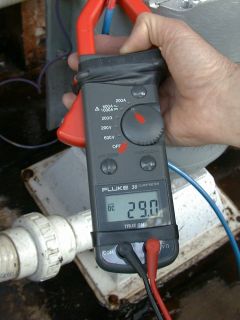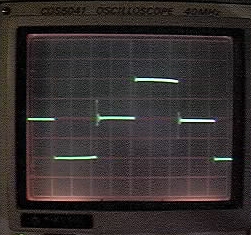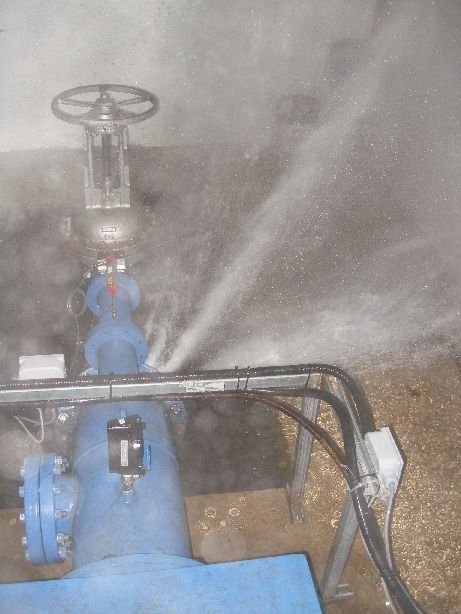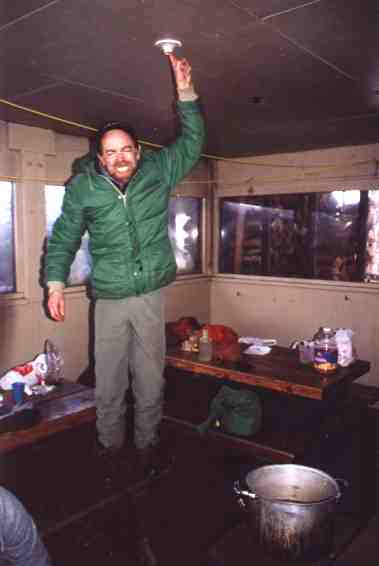Water to wire.... how the AC electricity is generated.
(See below for hydro definitions)
The following text explains the key components in a typical installation.
Water intake:
The process begins with the water in the creek having a potential energy equal to its mass times its height above the turbine mounted on the power house floor. The water is slowed in a pool so the sand can settle out. Larger debris is also filtered out here. Excess water passes over a low weir, or barrier, with a controlled amount entering a large pipeline or 'penstock'.
Penstock:
Water flows down the pipe at a slow rate of speed, typically 5 feet per second. The pressure steadily increases in proportion to the increasing drop. It is the high pressure that forces the water out the nozzle. The actual rate of flow in the penstock is relatively unimportant, unless the pipe is very long in which case an excessive amount of friction is created by the flowing water.
Turbine:
This is the heart of the energy conversion process which changes the waters velocity into mechanical energy. Water striking the curved blades of the turbine imparts its kinetic energy of motion on the blades. The turbine spins at slightly less than one half the jet velocity, and falls away from the turbine with virtually zero energy.
Spear Nozzle:
Manual control of the power produced can be made by adjusting the amount of water passing through the turbine. This is accomplished by adjusting a threaded spear which screws into the nozzle assembly where the penstock enters the turbine. This pinches off the flow in any amount required. Typically, the control is set to the maximum power required, and the governor then maintains control by dumping any excess power.
Generator:
Within the generator there are many coils of wire wound on iron cores attached to the generator frame. Rotating inside these coils is an iron core which produces strong magnetic fields. As the core rotates at 1800 revolutions per minute, the magnetic lines of force pass through the fixed windings. It is this process that produces the alternating current electricity. This same principle is used in all electric generators, from large hydro and nuclear plants to the alternator in your car, although the speed can vary depending on the type of generator used.
Governor:
This is the main controller for the entire system.
Precise powerline frequency is controlled by exactly balancing the load on the generator with the power delivered to the generator by the turbine. This is accomplished in several ways. Old systems relyed on centrifugal force to lift heavy spilling balls against gravity with the amount of lift dependant on the RPM. These weights were linked to an oil based servo drive which activated a spear valve or a jet deflector. This method was subject to a bit of delay, or droop, as it reacted to changing loads.
Modern micro hydro systems sense shaft RPM or power line frequency to govern the speed. This is done by either varying the amount of water hitting the turbine as with the mechanical governors, but providing a faster respone time and more precise frequency control. In addition, many stand alone systems use electronic governors which control frequency by rapidly switching on and off ballast loads, usually in a water filled load tank. Ideally, when water is in limited supplly, a system will take advantage of both methods.
Load tank:
This is generally made up of a large water tank, or series of separate tanks containing electric heating elements. Excess power is shunted to these elements from the governor thereby "putting the brakes on" the generator. This excess power is often used to heat primary domestic hot water in smaller, separate water tanks, one large central tank, or as a low priority source of heat for a pool or sauna. As lights are turned off in the buildings, the power is immediately directed to the ballast load to maintain the exact balance necessary for precise frequency control. Over the course of the night, large amounts of hot water can be produced and stored for use during the day. This method of frequency control maximizes the hydro plant capacity and reduces or eliminates the need for fossil fuel boilers.
Alarms:
The system alarm panel reports all the conditions of the various components. These can range from bearing temperatures, penstock pressure, line voltages and currents, phase imbalance, generator overspeed, unauthorized entry or any other parameter required. Minor alarms are displayed on the panel and relayed to an operator who can respond. In the rare event of a major system alarm, the governor can immediately shut the whole system down by activating a jet deflector which diverts the water jets away from the turbine. The main penstock valve can then be slowly closed by dc motors if required.
Active load Management:
The secret to how a 200 kW hydro plant can provide power to a total load of 300 kW or more.
In addition to the governor controlling the precise speed of the generator and hence line frequency, load management diverts available power to useful loads arranged in a pritorized sequence. The load manager is always testing the power being dumped in the ballest load and when there is sufficient excess, another prioritized load turns on. These consist of water tanks, space heaters, display lighting, dryers, freezers, or any other load that can be shut off for a period of time with no ill effect.
Base loads such as lighting, pumps, outlets, kitchen appliances, sound equipment, computers, communications etc. are always connected.
Load Center:
A load center is basically a large switch with up to 24 smaller switches serving as circuit breakers. These will protect the wires and equipment from potential short circuits or overloads. You will have a similar 'electrical panel' in your home. Each building at Malibu has a load center, and each load center will supply power to all the branch circuits in that building.
Definitions used with Micro Hydro
Here is a list of common terms and their explanation.
- Static head
The total available drop from intake to turbine nozzle.
- Net head
The useable head after subtracting losses from pipe friction etc.
- Flow
The quantity of water being used to produce power. this is usually measured in units of cubic feet per second, gallons or liters per second.
- Power
The rate of doing work, or energy expended per unit of time. Often used inter-changeably, thought not technically correct, with energy.
- Energy
The ability to do work, energy can be potential as in water behind a dam being acted upon by gravity. Energy can also be kinetic, that is, the combination of mass times velocity, as in moving water in a penstock or turbine nozzle.
- Kilowatt
One thousand watts .
- KiloWatt Hours
A 1000 watt light burning for one hour uses one kilo watts of energy for every moment it is turned on. It is constantly using energy at a rate of 1000 watts. If it burns for one minute it uses "one kilowatt minutes" If it burns for one hour, it uses "one kilowatt hours".. An average house uses between 10 and 30 kilowatt hours in a day, and that can be any combination of loads for any period of time that all add up to the total kilowatts in 24 hours.
It is sort to like saying your car goes 80 Km in an HOUR, rather than saying your car goes 80 Km in some random period of time, even though the mile posts are whizzing by at a high rate of speed. How much money do you earn? I earn 4 $ in an ? ( minute, hour, day month ? So you have to relate any quantity to a specific time period for it to have any meaning or value.
Ampere hours are similar to watt hours and are the product of amperes and volts multiplied together. Few folk talk about ampere hours unless they are dealing with battery based power systems.
- Volts and Amps
The units of electrical pressure and quantity. A typical outlet at home will provide about 15 amps at 117 volts.
- vars
The combination of volts and amps acting in a reactive circuit, that is, one that is either inductive, as in the case of a motor load, or capactive, as in the case of some forms of electronic loads. Vars are like Kilowatts, but since the volts and amps are out of phase, the product of the two is not the same as if they were acting on a non reactive circuit.
- Penstock
The name given to the pressure pipe line that delivers water from intake to turbine.
- Governor
Electronic equipment which monitors generator RPM and instantly adds or subtracts electrical load from the generator as a means of regulating or 'governing' the system speed and hence line frequency.
- Runner
A term given to the active energy converting part in a turbine. The 'runner' is generally cast from stainless steel or bronze alloy and intercepts the water flow from the penstock and extracts or converts about 80 to 85 percent of the waters energy into rotational energy.
- Micro Hydro
The term used for systems up to 100 kW.
- Mini Hydro
The term used for hydro systems from 100 kW up to 1 MW
- Small Hydro
The term used for hydro systems from 1 MW and up to .... around 50 MW.
|



